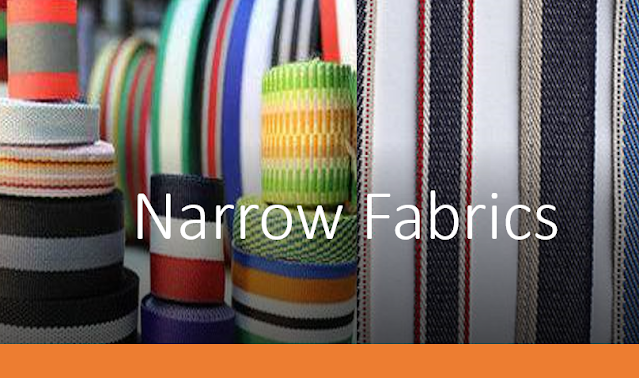
1. What are the narrow fabrics?
Narrow fabrics are any textile fabrics that are about 6-8 inches wide and have two woven selvages on either side of the fabric. They are small strips that are often used for a practical and specific purpose. Narrow fabrics have a unique characteristic that is in vehicles, narrow fabrics with carbon fiber can assume virtually any shape and be transformed into hard, protective surfaces through a heat and vacuum process.2. How narrow fabrics are manufactured?
Narrow Fabrics and their composites are made of are polyester, nylon, fibreglass, metallic and reflective yarns, carbon fibre, spandex, neoprene, rubber, cotton, polypropylene, rayon, aramid, and polytetrafluoroethylene (PTFE).They are manufactured in specialised looms which involves material selection, designing, developing, and manufacturing to produce a speciality product. They are weaved by the process of warp filling interlacing. Several sets of warp yarns may be beamed together to make several narrow fabrics side by side, on the same loom. Webbings are now a part of the major sector of the industry.
3. Looms for weaving narrow fabrics
Fabric up to 6 or 8 inches wide with selvage on two sides are woven in narrow ware looms. They were initially called tape looms. Some looms use a straight shuttle whereas some use the circular shuttle. The elastic webbing loom is gaining popularity with time. It is of three types: the looms for weaving garter webbing, the looms for weaving suspender webbing, and the looms for the wider elastic webbings used in connection with supporters and bandages. Ribbon looms are another type of loom which are specialized for making silk ribbons. More improvements were made in the ribbon looms with each passing year.4. Forms of narrow fabrics
Labels: These are small pieces of cloth that are used to identify products, their owner, maintenance, and other such things. There are two types of labels namely PVC rubber labels which are generally used for shoes, hats, and bags, and leather labels which are used for jackets and jeans.Braids: Made from three or more strands interwoven together in the form of a braid, is a rope-like structure having a diagonally overlapping pattern.
Elastics: These are soft and slim tape-like materials that is used in the manufacturing of underwear, sportswear, hand gloves, silicon bras, and so on.
Reflective tapes: They are generally heat and pressure-sensitive and are used for brand logos for various products.
5. Materials used to make narrow fabrics
Cotton: This is the most common material to make narrow fabric. It is mainly used to make wicks, tapes, webbings and so on.Satin: Used in laces, ribbon, tapes and other items which are used in decorations
Velvet: They give a classy and more attractive touch and are used in the manufacture of ribbons and webbings.
Nylon: Being durable in nature and also being available in various colours and texture, these are generally used for making straps and straws and is a favourite in the industry.
Jute: The 100% bio-degradable material is used for webbings.
Fibreglass: Highly popular due to its chemical properties these are generally used in the manufacturing of wicks.
Beads: Many apparels and garments nowadays have trims and fringes made up of tiny and shining beads. Hence these type of products is getting popular nowadays.
6. Categories of Narrow Fabric
Narrow fabrics can be divided into two categories:Elastic – Narrow fabrics that, when stretched, will return to their original shape and size fall into the elastic group. Elastics narrow fabric is typically made in widths between 1/8 inches and 12 inches wide.
Example: Non-slip elastic tape, waistband
Non-elastic – Narrow fabrics that, when stretched, change its shape is referred to as non-elastic narrow fabrics. Most of the narrow fabrics are non-elastic in nature.
Example: tapes, braids, webbings
7. Applications of Narrow Fabric
The narrow fabric has wide application in the apparel industry as well as other industries such as- Safety – military goods including parachutes, packs, cargo, and fire safety gears for fire-fighters
- Automotive – seatbelts and harnesses and sometimes it is used as a substrate for manufacturing surfboats, boats, and other vehicles.
- Sports – hiking and backpacking gear
- Aerospace – wirings that help in electrical power transmission
- Garment – pet collars, bra straps, waistbands, binding tapes, corsets
- Medical – non-elastic straps, also woven bifurcate that is used to treat aortic abdominal aneurysms, rigid gauze, bandages, and fiberglass bands, etc.
References
- https://www2.cs.arizona.edu/patterns/weaving/books/pea_nfw.pdf
- https://www.fibre2fashion.com/industry-article/4122/what-can-a-thin-strip-of-fabric-do-applications-of-narrow-fabrics
- https://www.textileschool.com/3383/narrow-fabrics-tapes-braids-and-webbings/
- https://www.bondproducts.com/narrow-fabrics/
- https://www.referenceforbusiness.com/industries/Textile-Mill/Narrow-Fabric-Other-Smallwares-Mills.html
Image source: Indiamart.com
About the Author:
Adita Banerjee is pursuing her graduate degree in Textile Technology from the Government College of Engineering and Textile Technology, Serampore. She loves writing content and reading books.
